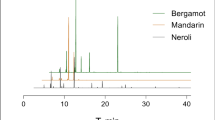Abstract
Tea tree oil distilled from Melaleuca alternifolia has widespread use in the cosmetic industry as an antimicrobial as well as for other functions in topical products. Concerns were first raised by the European Commission’s Scientific Committee on Consumer Products in 2004 about the level of the potentially carcinogenic phenylpropanoid compound methyl eugenol in tea tree oil. Limits on oil content in different types of cosmetic products were set based on a reported upper level of 0.9% methyl eugenol in the oil. A previous publication indicated that these levels were based on oil from a Melaleuca species not used in the commercial production of oil. Even the highest recorded levels in Melaleuca alternifolia, the overwhelmingly most common species used, were ∼15 times less than this, meaning that more oil could be safely used in the products. The current study, including details on methodology and reproducibility, extends that work across a suite of 57 plantation-sourced oils from a range of geographical locations and production years, as well as many Australian and international commercial oils. Lower levels of methyl eugenol in oils of known provenance were confirmed, with a recorded range of 160–552 ppm and a mean of 337 ppm. Analysis of variance showed methyl eugenol levels in Australian plantation oils to be correlated to the geographical region but not to the year of production. Average methyl eugenol levels in commercial oils were significantly lower, and these samples were divided into an authentic group and a group that were suspected of being adulterated based on an independent test. Authentic commercial oils had similar levels of methyl eugenol to Australian provenance material, whilst the oils classed as suspect had significantly lower levels.





Similar content being viewed by others
References
Carson CF, Hammer KA, Riley TV. Melaleuca alternifolia (tea tree) oil: a review of antimicrobial and other medicinal properties. Clin Microbiol Rev. 2006;19(1):50–62.
Dryden MS, Dailly S, Crouch M. A randomized, controlled trial of tea tree topical preparations versus a standard topical regimen for the clearance of MRSA colonization. J Hosp Infect. 2004;56:283–6.
Garozzo A, Timpanaro R, Bisignano B, Furneri PM, Bisignano G, Castro A. In vitro antiviral activity of Melaleuca alternifolia essential oil. Lett Appl Microbiol. 2009;49:806–8.
Groppo FC, Ramacciato JC, Simões RP, Flório FM, Sartoratto A. Antimicrobial activity of garlic tea tree oil and chlorhexidine against oral microorganisms. Int Dent J. 2002;52:433–7.
Hammer KA, Carson CF, Riley TV. Antifungal activity of the components of Melaleuca alternifolia (tea tree) oil. J Appl Microbiol. 2003;95:853–60.
Hart PH, Brand C, Carson CF, Riley TV, Prager RH, Finlay-Jones JJ. Terpinen-4-ol, the main component of the essential oil of Melaleuca alternifolia (tea tree oil), suppresses inflammatory mediator production by activated human monocytes. Inflamm Res. 2000;49:619–26.
ISO (2004) ISO 4730:2004 (E) Oil of melaleuca, terpinen-4-ol type. http://www.iso.org/iso/iso_catalogue/catalogue_tc/catalogue_detail.htm?csnumber=37033.
Wong YF, Davies NW, Chin ST, Larkman T, Marriott PJ. Enantiomeric distribution of selected terpenes for authenticity assessment of Australian Melaleuca alternifolia oil. Ind Crop Prod. 2015;67:475–83.
Southwell IA, Russell MF, Davies NW. Detecting traces of methyl eugenol in essential oils: tea tree oil, a case study. Flavour Fragr J. 2011;26:336–40.
Tan KH, Nishida R. Methyl eugenol: its occurrence, distribution, and role in nature, especially in relation to insect behaviour and pollination. J Insect Sci. 2012;12:56.
Phillips DH, Reddy MV, Randerath K. 32P-post-labelling analysis of DNA adducts formed in the livers of animals treated with safrole, estragole and other naturally-occurring alkenylbenzenes. II. Newborn male B6C3F1 mice. Carcinogenesis. 1984;5:1623.
International Fragrance Association (2009) IFRA Standard: Safrole, isosafrole, dihydrosafrole, estragole, methyl eugenol (October 14, 2009). http://ifraorg.org
European Commission (2002) Twenty-sixth Commission Directive 2002/34/EC of 15 April 2002 adapting to technical progress Annexes II, III and VII to Council Directive 76/768/EEC on the approximation of the laws of the Member States relating to cosmetic products. OJEC. 2002;L102:22. http://eur-lex.europa.eu/LexUriServ/LexUriServ.do?uri=OJ:L:2002:102:0019:0031:EN:PDF
European Parliament (2009) Regulation (EC) No 1223/2009 of the European Parliament and of the Council of 30 November 2009 on cosmetic products. OJEU. 2009;L342:59–202. http://eur-lex.europa.eu/LexUriServ/LexUriServ.do?uri=OJ:L:2009:342:0059:0209:en:PDF
European Commission (2004) Scientific Committee on Consumer Products: Final position paper on the use of products containing methyl eugenol (EMEA/HMPWP/337/03). http://www.ema.europa.eu/docs/en_GB/document_library/Position_statement/2009/12/WC500018034.pdf
European Commission (2008) Scientific Committee on Consumer Products: Opinion on Tea Tree Oil. Adopted 16.12.2008. p. 34. http://ec.europa.eu/health/ph_risk/committees/04_sccp/docs/sccp_o_160.pdf
VSN International (2014) GenStat for Windows, 16th edition. Hemel Hempstead: VSN International. www.GenStat.co.uk
Acknowledgements
This project received financial support from the Rural Industries Research and Development Corporation (RIRDC) and the Australian Tea Tree Industry Association (ATTIA Ltd).
Author information
Authors and Affiliations
Corresponding author
Ethics declarations
Conflict of interest
The authors declare that they have no conflict of interest.
Rights and permissions
About this article
Cite this article
Raymond, C.A., Davies, N.W. & Larkman, T. GC-MS method validation and levels of methyl eugenol in a diverse range of tea tree (Melaleuca alternifolia) oils. Anal Bioanal Chem 409, 1779–1787 (2017). https://doi.org/10.1007/s00216-016-0134-4
Received:
Revised:
Accepted:
Published:
Issue Date:
DOI: https://doi.org/10.1007/s00216-016-0134-4




